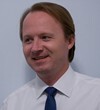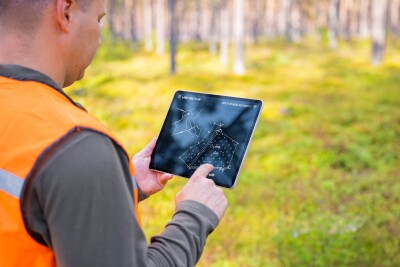As Sam Pfeifle reported, I recently had the pleasure of testing the first kinematic laser scanning system from p3d Systems GmbH. While Sam covered the business side of the venture I wanted to go more in depth about the scanning system and the experience as a whole.
First of all, WOW! It’s been awhile since someone brought something to my attention that was that far ahead of the curve without it coming from one of the larger manufacturers already in the lidar market. Since the video of me using the system went public the questions I get are:
- Does it really work? In a word, Yes.
- What type of accuracy are you getting? In the testing I did we saw errors around 4cm. However, we are talking about spot checks with targets that were also scanned by a Leica C10. The processing software has not been made available to me so I do not have any hard metrics on registration to control data. Dr. Christian Hesse of p3d Systems is scheduled to release a white paper on this topic at Intergeo the second week of October.
- How heavy is it? The camera arm, backpack, IMU, and hardware way about as much as the HDS7000 that we used for the testing. That totals about 44-45lbs/20kg. It’s heavy but the weight is distributed so that you really only feel it in your hips and legs.
- What kind of car was that in the background? It was a McLaren MP4-12C.
Now that we’ve covered those, let’s dive into some of the details that are not so obvious in the video. The system works the same way as most any mobile scanning unit. There is an IMU (Inertial Measurement Unit) to record pitch, roll, & yaw. There is a scanhead, and there is something recoding positional information. In this case we used a GPS receiver. Additionally, we set up a GPS reference station that recorded data while we used the portable scanning system. Finally, the reference data, mobile GPS data, IMU data, and point cloud are registered together in the yet-to-be-named post-processing software. This was done by Harald Vennegeerts of p3d Systems.
The first thing most people notice is the backpack style data collection. However, in my opinion the power of this unit is in the fact that your form of locomotion is irrelevant. Most of the time we used it on a wheeled dolly. Whenever we came to an obstacle that the dolly could not traverse we put the unit on the steady cam arm. If we needed less density but greater speeds we would mount the arm on the back of a golf cart. Other than needing to hold the unit still for about 5 minutes each time we switched to a different method of locomotion we didn’t have to alter the hardware or software at all.
As might be expected, the accuracy really comes down to the GPS signal. Currently there are no ways of monitoring GPS data in real-time on the tablet that is being used to control the unit. However, Harald indicated that they were considering adding the ability to monitor cycle slips, PDOP and constellation information in the release version of the field software. You monitor your scan data by viewing the profile image on the HDS7000’s screen. In conversations regarding increasing the accuracy of the unit, Christian mentioned that they had run tests using a prism and robotic total station for tracking as opposed to any GPS at all. While this limited the unit to line of sight use, by using a total station they were able to achieve sub-centimeter accuracy. I think we will see this feature eventually but I would not expect it in the initial public release.
Thus far I have seen four different projects completed using this system. Considering it is essentially in Alpha the results have been remarkably consistent. We did find some odd wave-like patterns in some instances. The patterns are similar to those you used to see in GPS data when using kinematic surveying methods prior to the use of RTK radios. Without direct access to the post-processing software I can’t say for sure but I suspect that the same principles are being used here with the stop and calibrate replacing the old method of swapping antennas. Every time we found these wave issues Harald was able to reprocess the data and correct the error. My assumption is that he was altering the elevation mask and acceptable PDOP range of the GPS data or leaning more on the IMU for those sections during processing.
As it was explained to me, p3d Systems plans to offer the hardware (most likely without a scanhead) and the processing software as commercial items at some point during the 2013 calendar year. Up until then, they may offer services using the equipment if it aids in the development of their product prior to its public release. I have been promised additional access and will post more reports as I see the system evolve, but I can already say that using the system has changed my thinking a bit. Previously I considered mobile scanning to be too big and inaccurate to appeal to much of my customer base. This type of mobility changes that. I cannot tell you how many meetings I’ve been in since using the system where I had to resist mentioning it as an option to solve some issue. Just think about being able to scan a site as quickly as you can walk through it! It is quite empowering until you see the size of the point cloud file at the end of the day! Another interesting facet is that this system brings a level of art back into field collection. I found myself thinking about “painting” surfaces while using the unit. I was constantly considering ways to angle my path through the environment or in orbit around an object to allow for greater coverage or point density. These are not issues you normally consider in real time and knowing that the unit is collecting all of the time lends to a feeling of pressure that can be a bit exhilarating. It’s like playing in a band or a huge 3D video game in that you are always aware that the clock is running. I’ve seen my data compared to Christian and Harald’s and there is definitely a learning curve to acquiring the right touch when moving through an environment. I look forward to improving my skillset as p3d Systems moves toward releasing the system. I would also like to express my gratitude to everyone at p3d Systems for their willingness to share in the development of this system; it has been an exciting process for me personally.
In addition to the video posted in the original story about the 3d systems, I have posted another video that not only shows the unit in some detail but also samples of the point cloud data we collected. You can see it here:
All of the data shown in the video was collected in under 15 minutes including initialization. The video actually shows me collecting all of the data shown in the point cloud sample in real time.





